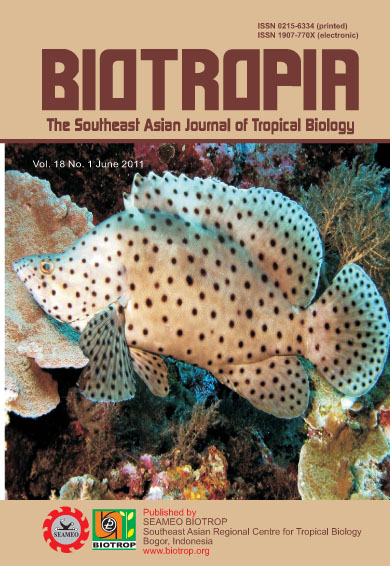
SEAMEO BIOTROP
Southeast Asian Ministers of Education Organization
631
views
Tags
COMPARISON OF THREE DIFFERENT TECHNIQUES OF GENE TRANSFER IN HUMPBACK GROUPER ( ) CROMILEPTES ALTIVELIS
23 May 2019 - 11:58 am (7 year ago)
Content Language : English
Content Language : English

Category :
Applied Science
Humpback grouper is one of the most cultured fishes in Asia, including Indonesia. The
main problemfaced by humpback culture is its slow growth rate.One of themethods that will
be more effective and efficient to solve the problem is using transgenic technique. This study
was conducted to determine the effectiveness of transfection,microinjection and electroporation
techniques on gene transfer in humpback grouper. transfection was performed by
incubating sperm to the foreign DNA (pktBP-ktGH gene construct)-transfectant complex
solution, while was by injecting those complex solution into testis of mature males.
Microinjection was conducted in 2-4 cell stage embryos using 25 μg/ml of foreign DNA
solution, and duration of injection was 1, 2 and 3 seconds. Electroporation by 50 V, 30 ms of
pulse length, 5 of pulse number and 0.1 of pulse interval was performed to sperm using three
DNA concentration of 5, 10 and 20 μg/ml. The incorporation of foreign DNA in sperm and
embryos were analyzed using PCR method. Based on PCR analysis, an optimum DNA
concentration for electroporation was 10 μg/ml. Limited number of embryos could be
microinjected during 20-30 min to reach 2-4 cell stage. Microinjection for 1 second showed
higher survival rate of embryos, although none or very low number of larvae was hatched.
Transfast was an effective DNA delivery reagent for humpback grouper sperm. Foreign DNA
could be detected in sperm from two out of ten transfected fish at least 36 hours post
transfection (hpt). By transfection, foreign DNA was detected in sperm at 48 hpt 25 C
incubation temperature. Our study revealed that transfection, microinjection as well as
electroporation could be used as transgenesis methods in humpback grouper. By means of
simplicity and efficacy, however, electroporationwas an appropriate gene transfermethod.
o
In vitro
in vivo
in vivo
in vitro
main problemfaced by humpback culture is its slow growth rate.One of themethods that will
be more effective and efficient to solve the problem is using transgenic technique. This study
was conducted to determine the effectiveness of transfection,microinjection and electroporation
techniques on gene transfer in humpback grouper. transfection was performed by
incubating sperm to the foreign DNA (pktBP-ktGH gene construct)-transfectant complex
solution, while was by injecting those complex solution into testis of mature males.
Microinjection was conducted in 2-4 cell stage embryos using 25 μg/ml of foreign DNA
solution, and duration of injection was 1, 2 and 3 seconds. Electroporation by 50 V, 30 ms of
pulse length, 5 of pulse number and 0.1 of pulse interval was performed to sperm using three
DNA concentration of 5, 10 and 20 μg/ml. The incorporation of foreign DNA in sperm and
embryos were analyzed using PCR method. Based on PCR analysis, an optimum DNA
concentration for electroporation was 10 μg/ml. Limited number of embryos could be
microinjected during 20-30 min to reach 2-4 cell stage. Microinjection for 1 second showed
higher survival rate of embryos, although none or very low number of larvae was hatched.
Transfast was an effective DNA delivery reagent for humpback grouper sperm. Foreign DNA
could be detected in sperm from two out of ten transfected fish at least 36 hours post
transfection (hpt). By transfection, foreign DNA was detected in sperm at 48 hpt 25 C
incubation temperature. Our study revealed that transfection, microinjection as well as
electroporation could be used as transgenesis methods in humpback grouper. By means of
simplicity and efficacy, however, electroporationwas an appropriate gene transfermethod.
o
In vitro
in vivo
in vivo
in vitro
Link

This work is licensed under a Creative Commons Attribution-NonCommercial-NoDerivatives 4.0 International License.
